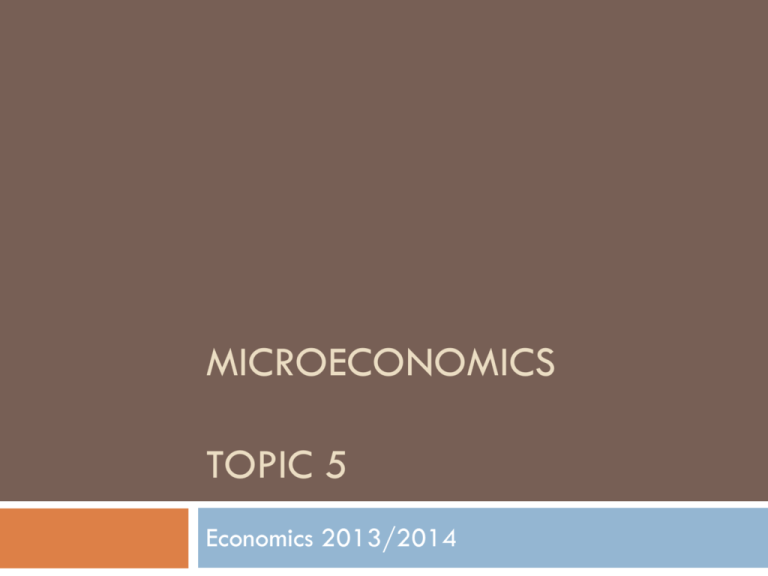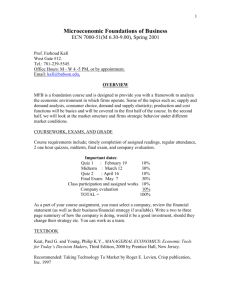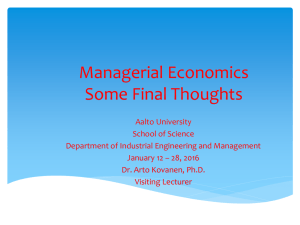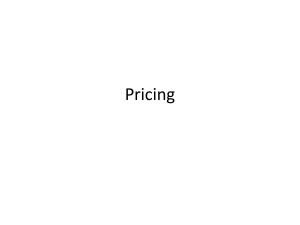Types of Markets PPT
advertisement

MICROECONOMICS TOPIC 5 Economics 2013/2014 TYPES OF MARKET 2 MAIN TYPES Perfect markets: do not exist in the real world Imperfect markets: do not have any of the characteristics of a perfect market. 4 types: Monopoly Oligopoly Monopolistic Monopsony competition PERFECT COMPETITION (MARKET) Characteristics: Large number of firms – firms are price takers Large number of buyers Freedom of entry and exit Perfect knowledge Homogeneous products MONOPOLY Only one dominant firm. The strength of any monopoly is determined by the barriers to entry and the availability of substitutes. They can charge above the normal price but don’t have a free reign on what they can charge as there will be a limit to what consumers will pay. A monopoly that is too powerful may be investigated by the government. A monopoly is any firm that holds more than 25% of a market. OLIGOPOLY The market here is dominated by a few large firms. Markets that have this structure are soap powder, supermarkets and petrol. A firm with two dominant firms are called a DUOPOLY. Each firm has a branded or differentiated product. It has a lot of influence in the market and can affect its own and competitors’ market share. To expand or maintain market share, firms will tend to use non-price methods. This can include advertising or branding. Competing on price can lead to costly price wars which is not good for business. Firms sometimes in this type of market will collude to fix prices, limit output or share out a market. This is called a CARTEL. MONOPOLISTIC COMPETITION There are a large number of firms but each firm produces a branded or differentiated product. Each firm has a bit of control over price and its market share. There are weak barriers to entry. Examples: restaurants, taxi businesses, hairdressers. MONOPSONY This is a market where there is only one buyer. The buyer has a huge amount of power to dictate price, product, design and delivery. Supermarkets have a degree of monopsony power over many of their suppliers. PRODUCT DIFFERENTIATION This is when suppliers try to create differences between their products and those of the competition. Real differences include: design and quality Imaginary differences include: advertising and brand image. BARRIERS TO ENTRY These prevent any potential competitors from getting into an industry. They can either be deliberate or natural. DELIBERATE BARRIERS Marketing Barriers High spending on advertising can create a strong brand image and loyalty, which new firms will find hard to overcome. eg washing powder, breakfast cereals Restrictive Trade Practices A strategy that restricts competition Refusing to sell to a retailer who buys from a rival Refusing to sell unless they buy the whole range Using predatory pricing to drive out competition NATURAL BARRIERS Capital costs Entry costs to some industries are very high. Eg car manufacturing. Sunk costs These are costs that can’t be recovered if they firm fails. Can include advertising costs or R&D. Economies of Scale Large firms can gain huge economies of scale that new entrants will find hard to compete with as existing firms will have lower average cost. Legal barriers The law can prevent new entrants to a market. Examples include: patents and copyrights. PRICING PERFECT MARKETS The price here is determined by the interaction of demand and supply. Each firm has to accept the equilibrium price for their market. Each firm is a PRICE TAKER. IMPERFECT MARKETS Firms in these markets can adopt a number of strategies. The decision on what to price is determined by how much competition there is. Fall into two groups: COST-BASED PRICING Cost-plus pricing Price is set by working out the AC and adding a mark up for profit. E.g. AC is £1 and mark up is 10% then the price would be £1.10. Firms with little competition can use this method Advantages to Cost-Plus Pricing It is a very quick and easy method Ensures sales revenue will cover TC and make the firm profits Disadvantages of Cost-Plus Pricing Fixed mark-up could be a problem if new competition was to enter the market Contribution (marginal cost) Pricing Price is set to cover VC. As long as price more than covers VC a contribution will be made towards FC. If enough orders are received so that contribution equals FC then the firm will break-even. If contribution is greater than FC then profit is made Advantages of Contribution Pricing More flexible than cost-plus Pricing of products can take into account competitors prices and demand by customers Can be used during poor trading, so long as VC are covered and a contribution is made to FC CUSTOMER-ORIENTATED PRICING Competition-based Pricing When there is strong competition firms may base their price on what other firms in the market are charging. There may a price leader, who sets their price and the rest of the market follows e.g. petrol Penetration Pricing New entrants will set a price below existing suppliers to gain a foothold in the market The hope is that consumers will become loyal to the brand and continue to buy when the price is increased. Predatory Pricing Used by existing firms to push out competition from the market. The firm will lower their prices so that new entrants will not be able to cover its covers. Existing firm covers its lost by CROSS-SUBSIDISING. MONOPOLY PRICING Charging what the market will bear Suppliers of unique products can charge the highest price they think consumers will pay Psychological Pricing Products may be priced above competition to create the idea of better quality. Price Skimming Suppliers of new products may charge a high price to begin with in order to maximise revenues before competitors enter the market. Price Discrimination Firms over the same product but over different prices to different types of consumers.








